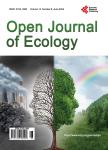Flight Behavioural Responses for African Ungulates across Species and Vegetation Covers in a Trophy Hunting Ecosystem: A Case Study from Selous Game Reserve, Tanzania
Flight Behavioural Responses for African Ungulates across Species and Vegetation Covers in a Trophy Hunting Ecosystem: A Case Study from Selous Game Reserve, Tanzania作者机构:Department of Wildlife Management Sokoine University of Agriculture Morogoro Tanzania Department of Forest and Environmental Economics Sokoine University of Agriculture Morogoro Tanzania Department of Zoology University of Oxford Oxford United Kingdom Tanzania Research and Conservation Organization Morogoro Tanzania GELIFES Institute University of Groningen Groningen Netherlands
出 版 物:《Open Journal of Ecology》 (生态学期刊(英文))
年 卷 期:2023年第13卷第8期
页 面:525-535页
学科分类:0710[理学-生物学] 071001[理学-植物学] 07[理学]
主 题:Trophy Hunting Animal Behavior Flight Initiating Distance Vegetation Types Wildlife Species
摘 要:Trophy hunting has severe consequences on wild animals’ behaviors, which in return has implications for affecting wildlife populations. The Selous Game Reserve is a protected area in Tanzania that has been subjected to commercial trophy hunting for decades, and information about the effects of trophy hunting on animals’ welfare is still scarce. The Flight Initiating Distance (FID) can be a good measure to evaluate the welfare of animals and the level of risk perception towards anthropogenic disturbances, including trophy hunting. The study used linear mixed models to assess the flight responses of twelve commonly hunted species in the Selous game reserve (S.G.R.). The study compared animal vigilance between species, vegetation types, and group size. The FID varied between species, with which more vigilance was observed in zebras, elands, wildebeests, and sable antelopes. The study found a significant influence of vegetation cover on individual species’ FID. Further, the study found a significant influence of group size on animals’ vigilance (L. M. M., 95% CI = 0.590 - 4.762), in which there was a decrease in FID with an increase in group size for wildebeests. At the same time, other species, such as buffaloes, eland, hartebeests, and zebras, had their FIDs increasing with the increase in group size. We conclude that the impact of trophy hunting on savannah ungulates varies between species, vegetation covers, and group size of individual species. Regulatory authorities should consider minimum approach distances by trophy hunters in different vegetation cover to reduce animal biological disturbances.



